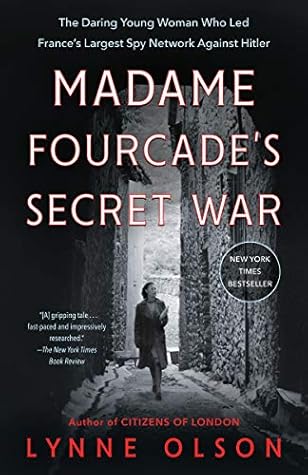More on this book
Community
Kindle Notes & Highlights
by
Lynne Olson
Read between
July 27 - August 12, 2020
fiendishly
Bertrand passed the material to Polish cryptographers, who had long given top priority to breaking the military codes of Germany, Poland’s hereditary enemy. As a result of Bertrand’s largesse, the Poles in 1934 became the first to crack the Enigma code.
Bertrand’s department cooperated closely with the British government’s codebreaking operation at Bletchley Park, which, just before the war began, had received from the Poles a copy of the Enigma machine, along with detailed information on how to use it.
Most of the newcomers were former members of the French army and air force; almost none had served in the navy.
mole,
According to the historian Robert O. Paxton, “Collaboration was not a German demand…[it] was a French proposal.”
Combat, which would become one of the largest and most influential underground organizations in all of France.
The German high command in Paris, which strongly supported Laval, was furious and put pressure on Pétain to release and reinstate him. Although Laval was set free, the marshal dragged his feet on returning him to his post.
Britain’s Secret Intelligence Service (MI6) about collaboration with Crusade.
bobsled
Founded in the eleventh century, Pau was the birthplace of Henri de Navarre, the future King Henry IV, whose castle overlooked the town.
pigsty
In fact, he was Commander Kenneth Cohen, the head of MI6 operations in Vichy France.
MI6 officials, who tended to be wellborn former military officers with substantial private incomes, many of them charter members of the clubby, upper-class “old boy network” that had dominated British society for generations.
MI6, whose operations in Europe had been virtually wiped out in the 1940 German blitzkrieg, did not have a single agent in place who could communicate back to London the information the government so desperately needed.
Starved of government funds after World War I, MI6 was underfinanced, understaffed, and woefully short of both talent and technology.
fraught
put together a far-flung spy network, called the Confrérie de Notre Dame,
the second French section, under Kenneth Cohen, focused on members of the military intelligence services now headquartered in Vichy,
When the secretary remarked how “very distressing” the news was, Churchill glared at him. “Distressing?” he exclaimed. “It is terrifying! If it goes on, it will be the end of us.” Top German officials agreed.
while German and French engineers designed and built huge submarine pens with concrete roofs thick enough to withstand Allied bombing raids.
rechristened the network. It would now be called Alliance.
daunted
sleuthing,
Paris and the rest of occupied France were under the command of the German
military, which had been quick to requisition the capital’s best hotels for their headquarters. The army’s high command had taken over the Majestic, off the avenue Kléber,
Yet some Parisians in her former social circle had seen little or no change in their privileged lives, except that they were now socializing primarily with their occupiers.
Cartier and Van Cleef & Arpels and haute couture clothing by designers such as Balenciaga, Dior, Nina Ricci, Paul Poirier, and Jacques Fath. Most of the designers continued to stage fashion shows during the occupation, but the audience needed special passes to get in. Some were given to the wives of German officials, but most were handed out to Frenchwomen.
the occupiers dominated every cultural and social institution in Paris, among them the opera, art galleries, auction houses, cabarets, and music halls.
“Many French women…remained as fashion-concious as possible during the war in order to retain their pride, boost morale, and remain true to themselves, because fashion expressed their identity.”
lunch at Maxim’s,
Its frequent customers included Luftwaffe chief Hermann Goering, who always ate there during his art-raiding trips to the French capital.
roguish
Admiral Darlan,
To help speed up the transmission of intelligence to London, the British had dispatched three more transmitters. One was sent to Marseille, a second to Colonel Bernis’s operation in Monaco, and a third held in reserve.
All of them were transported into France by Jean Boutron, who now served in an undercover role as Vichy’s assistant naval attaché in Madrid.
In response to the German attack, Moscow had ordered the French Communist Party to launch an armed struggle against munitions factories and German troops in France, in hopes of weakening the Reich’s Russian campaign.
In retribution, ninety-seven additional French hostages were shot.
The French people, already restive over growing food and fuel shortages, were infuriated by the wanton killing of their compatriots, and resistance efforts against the Germans grew noticeably stronger, especially in the free zone.
more than three hundred Nazi operatives, many of them French nationals, had been arrested in the free zone and handed over to French military courts. Of these, sixteen had been executed.
only possible way to save her from prison and the network from destruction was to smuggle her across the border to Spain, he said. Like it or not, she must go with him to Madrid, reveal her true identity to the British, and seek their aid.
Boutron contacted Georges Charaudeau, a wealthy French businessman who lived part-time in Spain and was the intended recipient of the cognac. Charaudeau had formed a small anti-German intelligence organization of his own, in league with MI6, that operated in both Spain and France.
Heinrich Himmler and Admiral Wilhelm Canaris—were occasional visitors to the Spanish capital and, along with their subordinates, were feted at lavish parties by members of Madrid’s high society, most of whom were pro-Franco and pro-Axis.
She felt she had to prove herself before letting Cohen and the others know who she was.
bleaker.
scolded
nodded.
tram
Colonel Édouard Kauffmann,
alacrity.


